Food And Drinks
Exploring How Big is a 10 oz Steak?
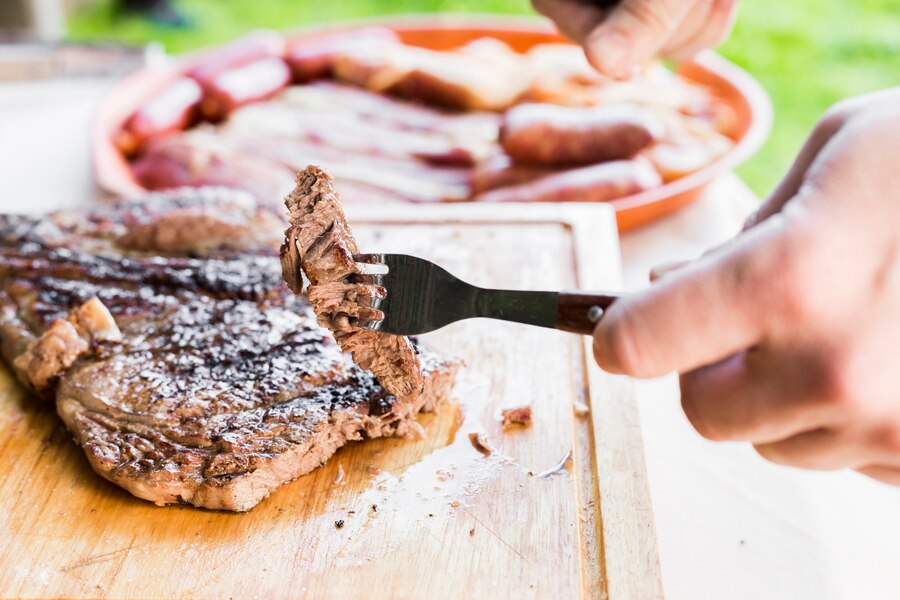
Introduction
When it comes to enjoying a steak, size can be a significant factor in both satisfaction and nutritional intake. A 10 oz steak is a popular choice for many steak lovers, but just how big is it? In this guide, we’ll break down what a 10 oz steak really means, compare it to other steak sizes, and provide tips for cooking and serving this delicious cut of meat.
Understanding Steak Measurements
What Does 10 oz Mean?
When you hear “10 oz steak,” it refers to the weight of the steak before cooking. This measurement is used to describe the raw weight of the meat, which can help estimate portion sizes and cooking times.
Steak Cut Types
Steaks come in various cuts, each with its own characteristics. Understanding the cut can give you a better idea of what to expect in terms of size and flavor. Common cuts include ribeye, sirloin, filet mignon, and T-bone, each with its unique size and texture.
Visualizing a 10 oz Steak
Comparisons with Everyday Objects
To get a better grasp of how big a 10 oz steak is, imagine the size of a thick, hearty sandwich or a large serving of meat from a typical restaurant plate. It’s roughly the size of a large palm or about the thickness of a standard smartphone.
Portion Size vs. Recommended Serving
While a 10 oz steak might seem substantial, it’s important to note that portion sizes can vary based on individual dietary needs and preferences. The recommended serving size for steak typically ranges between 4 to 6 ounces, making a 10 oz steak quite generous.
Popular Steak Cuts and Their Sizes
Ribeye
The ribeye is known for its marbling and rich flavor. A 10 oz ribeye steak is a decent size, offering a satisfying meal with plenty of tenderness and juiciness.
Sirloin
Sirloin steaks are leaner compared to ribeyes. A 10 oz sirloin steak is substantial but not as rich in fat, making it a popular choice for those who prefer a leaner cut.
Filet Mignon
Filet mignon is renowned for its tenderness. A 10 oz filet mignon is a hearty portion, offering a luxurious and buttery texture.
T-Bone
The T-bone steak features both the tenderloin and strip steak. A 10 oz T-bone steak includes a good mix of textures and flavors, making it a favorite among steak enthusiasts.
Cooking a 10 oz Steak
Recommended Cooking Techniques
For a 10oz steak, grilling, pan-searing, or broiling are excellent cooking methods. Each technique will enhance the steak’s flavor and texture, so choose based on your preference and available equipment.
Doneness Levels and Their Impact on Size
The doneness level affects the steak’s size after cooking. A medium-rare steak will be slightly larger than a well-done steak due to moisture loss during cooking.
Nutritional Information
Caloric Content
A 10 oz steak generally contains about 700 to 800 calories, depending on the cut and cooking method. This makes it a hearty meal option, especially if paired with sides.
Protein and Fat Content
A 10oz steak is rich in protein, providing approximately 60 to 70 grams per serving. Fat content can vary, with cuts like ribeye having higher fat compared to leaner options like sirloin.
Health Considerations
While steak is a good source of protein and essential nutrients, it’s important to consume it in moderation. Balance your diet with vegetables and whole grains to maintain overall health.
Serving Suggestions
Accompaniments and Sides
A 10 oz steak pairs well with various sides, such as roasted vegetables, mashed potatoes, or a fresh salad. Consider complementing it with a light, flavorful sauce or a side of steamed greens.
Ideal Portion Sizes for a Balanced Meal
While a 10oz steak is a generous portion, balance it with smaller side dishes to create a well-rounded meal. This helps ensure you get a variety of nutrients while enjoying your steak.
Buying and Preparing a 10 oz Steak
Tips for Selecting Quality Steak
When buying a 10oz steak, look for cuts with good marbling and a bright red color. Ensure the meat is fresh and free of any unpleasant odor.
Preparation and Marinades
Before cooking, season your steak with salt and pepper or marinate it to enhance flavor. Marinating for a few hours can also tenderize the meat and add extra flavor.
Comparing with Other Steak Sizes
6 oz vs. 8 oz vs. 12 oz Steaks
Comparing steak sizes can help you understand portion differences. A 6 oz steak is smaller and suitable for lighter appetites, while a 12 oz steak offers a larger portion for more substantial meals. The 8 oz steak is often a middle ground, providing a balanced portion size.
Impact on Dining Experience
The size of the steak can affect your overall dining experience. Larger steaks like the 10 oz offer more meat, which can be satisfying but may require more sides to balance the meal.
Conclusion
A 10 oz steak is a hearty and satisfying portion, ideal for those who enjoy a substantial meal. Understanding its size in comparison to other portions can help you make informed choices about your dining experience. Whether you prefer a ribeye, sirloin, or filet mignon, knowing how big a 10oz steak is and how to cook it perfectly can enhance your meal.
FAQs
- How big is a 10 oz steak in terms of plate size?
- A 10oz steak typically takes up a significant portion of a standard dinner plate, often covering about half of the plate’s surface area.
- Is a 10 oz steak considered a large portion?
- Yes, a 10oz steak is considered a large portion, especially compared to the standard serving size of 6 to 8 ounces.
- How does a 10 oz steak compare to other common food portions?
- A 10oz steak is roughly equivalent to two servings of chicken breast or a substantial serving of fish. It’s a hearty portion that provides a generous amount of protein.
- What is the best way to cook a 10 oz steak?
- Grilling, pan-searing, and broiling are all excellent methods for cooking a 10oz steak. Choose based on your preference for flavor and texture.
- How can I ensure my 10 oz steak is tender and flavorful?
- To ensure tenderness and flavor, use quality meat, season or marinate before cooking, and avoid overcooking. Let the steak rest after cooking to allow juices to redistribute.
Food And Drinks
5 Cinco de Mayo Drinks to Spice Up Your Fiesta

Ever wondered why margaritas dominate Cinco de Mayo celebrations? While this iconic drink is a staple, there’s a whole world of vibrant, flavorful beverages that can elevate your fiesta. Whether you’re hosting a party or simply want to enjoy a festive drink, we’ve got you covered with expert-backed recipes, modern twists, and must-try classics.
Let’s dive into the best Cinco de Mayo drinks—beyond the basic margarita—that will impress your guests and keep the celebration lively!
1. The Classic Margarita (With a Twist)
No Cinco de Mayo is complete without a margarita, but why stick to the ordinary?
Why It Works:
-
Balanced flavors – The perfect mix of sweet, sour, and salty.
-
Customizable – Swap tequila for mezcal for a smoky twist.
Recipe:
-
2 oz reposado tequila
-
1 oz fresh lime juice
-
½ oz triple sec
-
½ oz agave syrup
-
Salt rim (optional)
Pro Tip: Use chili salt for an extra kick!
2. Paloma: Mexico’s Most Popular Cocktail
Move over, margarita—the Paloma is Mexico’s true favorite.
Why It Works:
-
Refreshing & light – Grapefruit soda (like Jarritos or Squirt) keeps it bubbly.
-
Easy to batch – Perfect for parties.
Recipe:
-
2 oz blanco tequila
-
½ oz lime juice
-
Grapefruit soda (to top)
-
Salt rim (optional)
Upgrade It: Use fresh grapefruit juice + club soda for a less sweet version.
3. Michelada: The Ultimate Beer Cocktail
If you love spicy, savory drinks, the Michelada is a must-try.
Why It Works:
-
Umami-rich – Combines beer with lime, hot sauce, and spices.
-
Hangover helper – The electrolytes from the spices help recovery.
Recipe:
-
1 bottle Mexican lager (e.g., Modelo or Victoria)
-
1 oz lime juice
-
2 dashes hot sauce (Valentina or Cholula)
-
½ tsp Worcestershire sauce
-
Tajín rim
Spicy Version: Add a splash of Clamato for a Chelada.
4. Horchata RumChata Cocktail
For a sweet, creamy alternative, try this spiked horchata.
Why It Works:
-
Dessert-like – Cinnamon and vanilla flavors pair perfectly with rum.
-
Non-tequila option – Great for those who prefer something different.
Recipe:
-
1.5 oz RumChata
-
1 oz vanilla vodka
-
1 oz horchata (store-bought or homemade)
-
Cinnamon sprinkle
Frozen Version: Blend with ice for a milkshake-style treat!
5. Mezcal Mule (A Smoky Alternative)
If you love Moscow Mules, this Mexican-inspired version will blow you away.
Why It Works:
-
Mezcal’s smokiness adds depth to the classic ginger-lime combo.
-
Copper mug optional – Serve over ice for simplicity.
Recipe:
-
2 oz mezcal
-
½ oz lime juice
-
4 oz ginger beer
-
Candied ginger garnish
Extra Kick: Add a dash of chili powder to the rim.
Bonus: Non-Alcoholic Agua Fresca
Not drinking alcohol? No problem! Agua fresca is a refreshing, fruity alternative.
Why It Works:
-
Naturally sweet – Made with fresh fruit and water.
-
Kid-friendly – Perfect for all ages.
Recipe:
-
2 cups chopped watermelon (or pineapple, mango)
-
1 cup water
-
1 tbsp lime juice
-
1 tsp honey (optional)
Blend, strain, and serve over ice!
Final Thoughts: Which Drink Will You Try?
Cinco de Mayo Drinks are all about bold flavors and festive vibes. Whether you’re sipping a spicy Michelada, shaking up a mezcal mule, or keeping it classic with a margarita, these drinks will make your celebration unforgettable.
Pro Hosting Tip: Set up a DIY drink station with different rims (salt, Tajín, chili powder) and let guests customize their cocktails!
Food And Drinks
Crispy Potato Balls Recipe: The Ultimate Comfort Food Snack
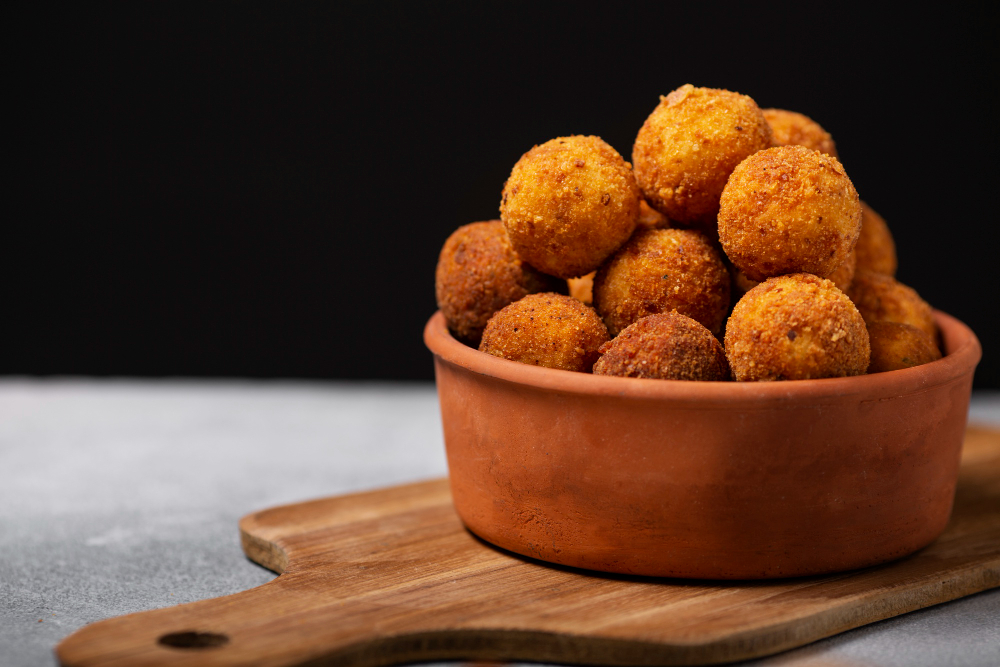
Ever crave a crispy, golden snack that’s creamy on the inside and perfectly crunchy on the outside? Potato balls are the answer! Whether you know them as croquettes, aloo balls, or papas rellenas, these bite-sized delights are a universal favorite.
In this guide, you’ll learn how to make restaurant-quality potato balls at home—crispy on the outside, fluffy inside, and packed with flavor. We’ll cover expert tips, variations, and even how to store them for later. Let’s get cooking!
Why You’ll Love This Potato Balls Recipe
✔ Easy to make – Uses simple, pantry-friendly ingredients.
✔ Versatile – Customize fillings (cheese, meat, herbs, or spices).
✔ Crowd-pleaser – Perfect for parties, snacks, or meal prep.
✔ Kid-friendly – A fun way to sneak in veggies or protein.
Ingredients You’ll Need
For the Potato Mixture:
-
4 large potatoes (Russet or Yukon Gold)
-
2 tbsp butter (or olive oil for dairy-free)
-
¼ cup milk (or plant-based milk)
-
½ tsp salt (adjust to taste)
-
¼ tsp black pepper
-
¼ tsp garlic powder (optional)
For the Filling (Optional but Delicious!):
-
½ cup shredded cheese (cheddar, mozzarella, or pepper jack)
-
¼ cup cooked bacon, ham, or ground beef
-
2 tbsp finely chopped herbs (parsley, chives, or cilantro)
For Breading & Frying:
-
1 cup breadcrumbs (panko for extra crunch)
-
½ cup all-purpose flour
-
2 eggs (beaten)
-
Oil for frying (vegetable, canola, or air-fryer option)
Step-by-Step Instructions
1. Prep the Potatoes
-
Peel, chop, and boil potatoes until fork-tender (~15 mins).
-
Drain well, then mash with butter, milk, salt, and spices until smooth. Let cool.
Pro Tip: Overcooked potatoes can get gluey—stop when just tender!
2. Shape the Potato Balls
-
Scoop ~2 tbsp of mashed potatoes, flatten slightly, and add filling (cheese, meat, etc.).
-
Roll into smooth balls (about 1.5-inch diameter).
Pro Tip: Wet hands slightly to prevent sticking.
3. Bread for Crispiness
-
Roll each ball in flour → dip in beaten egg → coat with breadcrumbs.
-
Chill for 15 mins (helps them hold shape while frying).
4. Fry to Golden Perfection
-
Heat oil to 350°F (175°C).
-
Fry in batches for 2-3 mins until deep golden brown.
-
Drain on a paper towel.
Alternative Cooking Methods:
-
Air Fryer: Spray with oil, cook at 375°F for 10-12 mins, flipping halfway.
-
Baked: Brush with oil, bake at 400°F for 20-25 mins.
5 Expert Tips for the Best Potato Balls
-
Use Starchy Potatoes – Russets or Yukon Golds hold shape better than waxy varieties.
-
Keep the Mixture Dry – Excess moisture = soggy balls. Drain potatoes well!
-
Double-Breading Trick – For extra crunch, dip in egg and breadcrumbs twice.
-
Freeze for Later – Freeze before frying, then cook straight from frozen (add 1-2 mins frying time).
-
Serve with Dipping Sauces – Try garlic aioli, spicy ketchup, or sour cream.
Creative Variations to Try
-
Loaded Potato Balls – Add bacon bits, cheddar, and green onions.
-
Spicy Version – Mix in jalapeños or chili flakes.
-
Veggie-Packed – Fold in finely chopped spinach or corn.
-
Sweet Twist – Swap salt for cinnamon, stuff with Nutella or jam.
Final Thoughts: Crispy Potato Balls Recipe
Crispy Potato Balls Recipe, creamy, and endlessly customizable—making them a foolproof snack for any occasion. Whether you fry, bake, or air-fry them, they’re guaranteed to disappear fast!
Now it’s your turn: Which filling will you try first? Cheese? Spicy beef? Or maybe a sweet surprise? Drop your favorite combo in the comments!
FAQs About Crispy Potato Balls Recipe
Can I make these ahead?
Yes! Prep and refrigerate for up to 24 hours or freeze for 3 months.
Why do my potato balls fall apart?
Potatoes may be too wet, or breading wasn’t packed tightly. Chill before frying.
Can I use sweet potatoes?
Absolutely! Adjust spices (try paprika or cumin for a savory twist).
Food And Drinks
Creamy Tuscan White Bean Skillet: A Comfort Food Masterpiece
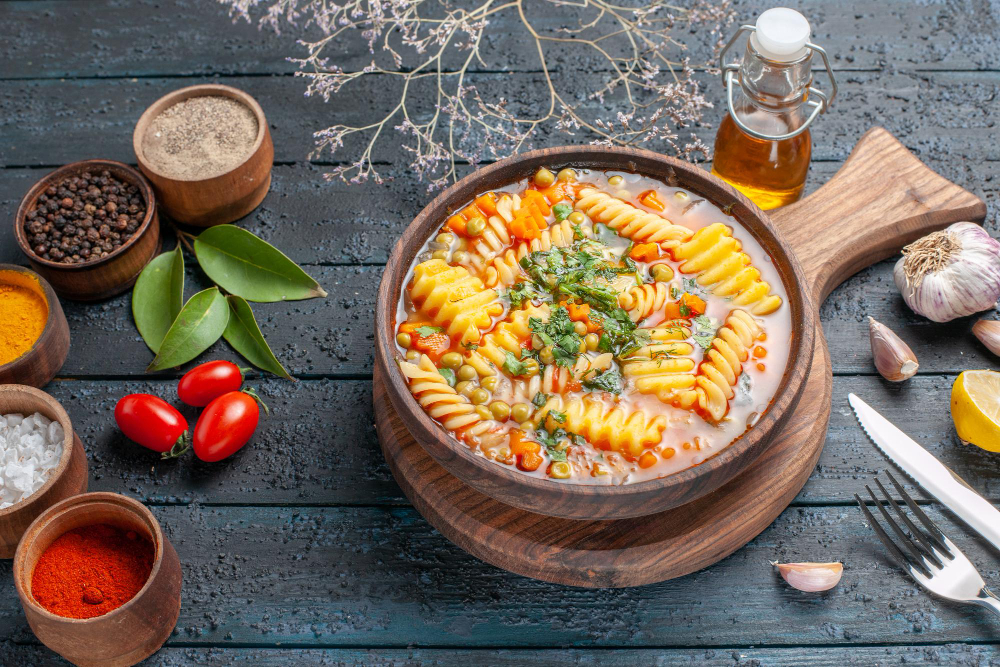
Ever crave a restaurant-quality meal but dread the long prep time? Imagine a dish that’s creamy, garlicky, packed with protein, and ready in 20 minutes. That’s the magic of a Creamy Tuscan White Bean Skillet—a one-pan wonder that’s hearty, healthy, and bursting with Italian-inspired flavors.
Whether you’re a busy parent, a meal-prep enthusiast, or just someone who loves rich, comforting food, this dish delivers. Let’s break down why it’s a must-try, how to make it perfectly, and expert-backed tips to elevate it.
Why This Dish Works (Nutrition & Flavor Science)
Before diving into the recipe, let’s explore why this skillet meal is a nutritional and culinary powerhouse:
✅ Plant-Based Protein Punch – White beans (like cannellini) offer 15g protein per cup, plus fiber for lasting energy.
✅ Healthy Fats – Olive oil and a touch of cream (or dairy-free alternatives) provide satiating fats without heaviness.
✅ Umami & Depth – Sun-dried tomatoes, garlic, and Parmesan (or nutritional yeast) create a savory, complex flavor profile.
✅ Quick & Adaptable – Works as a main dish, side, or meal-prep staple—gluten-free, vegetarian, and easily veganized.
“Beans are one of the most underrated superfoods—they’re affordable, shelf-stable, and incredibly versatile.” — Dr. Mark Hyman, Functional Medicine Expert
The Ultimate Creamy Tuscan White Bean Skillet Recipe
Ingredients (Serves 4)
-
2 tbsp olive oil
-
4 garlic cloves, minced
-
1 shallot (or small onion), diced
-
1 tsp Italian seasoning
-
½ tsp red pepper flakes (optional)
-
2 cups cooked white beans (or 1 can, drained)
-
½ cup sun-dried tomatoes, chopped
-
1 cup baby spinach (or kale)
-
½ cup vegetable broth
-
¼ cup heavy cream (or coconut milk for vegan)
-
¼ cup grated Parmesan (or nutritional yeast)
-
Salt & pepper to taste
-
Fresh basil or parsley for garnish
Step-by-Step Instructions
1️⃣ Sauté Aromatics – Heat olive oil in a skillet. Add garlic, shallot, Italian seasoning, and red pepper flakes. Cook until fragrant (1-2 min).
2️⃣ Add Beans & Sun-Dried Tomatoes – Stir in white beans and sun-dried tomatoes. Let them soak up the flavors (2-3 min).
3️⃣ Deglaze & Simmer – Pour in broth, scraping up any browned bits. Add spinach and cook until wilted.
4️⃣ Creamy Finish – Reduce heat, stir in cream and Parmesan. Simmer until slightly thickened (3-4 min).
5️⃣ Garnish & Serve – Top with fresh herbs and a drizzle of olive oil. Pair with crusty bread or over pasta.
Pro Tips for the Best Results
1. Bean Choice Matters
-
Cannellini beans are classic, but Great Northern beans or even chickpeas work.
-
For creamier texture, mash a few beans before adding liquid.
2. Flavor Boosters
-
Lemon zest brightens the dish.
-
Miso paste (½ tsp) adds umami depth.
-
Crispy pancetta (or mushrooms) for a meaty twist.
3. Meal-Prep Friendly
-
Stores well for 3-4 days in the fridge.
-
Freezes beautifully—just omit dairy and add it fresh when reheating.
Why This Skillet Beats Takeout
-
Cost-Effective – A fraction of the price of restaurant meals.
-
Customizable – Swap in seasonal veggies (asparagus, zucchini).
-
Fast Cleanup – One pan = less mess.
“The combination of fiber, protein, and healthy fats in this dish helps stabilize blood sugar, making it a great balanced meal.” — Nutritionist Kelly LeVeque
Final Thoughts: A Dish You’ll Make Weekly
The Creamy Tuscan White Bean Skillet is proof that simple ingredients can create extraordinary meals. Whether you need a quick weeknight dinner or an impressive dish for guests, this recipe delivers.
Try it tonight and taste the magic of Tuscan comfort—without the fuss.
-
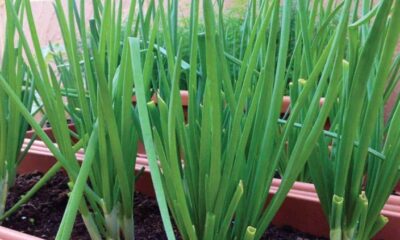
 Articles3 months ago
Articles3 months agoHow Many Times Can You Regrow Green Onions
-

 News11 months ago
News11 months agoUnderstanding HotLeaks: What You Need to Know
-

 Fashion8 months ago
Fashion8 months agoOpals in the USA: A Gemstone Transforming the Crystal Healing Market
-

 Entertainment8 months ago
Entertainment8 months agoHow to Use Snaptik: A Complete Guide to Download TikTok Videos
-

 Technology1 year ago
Technology1 year agoThe Wonders of Oh Em Gee Blog
-

 Entertainment1 year ago
Entertainment1 year agoBare it All: Unforgettable Skinny Dipping Stories Shared
-
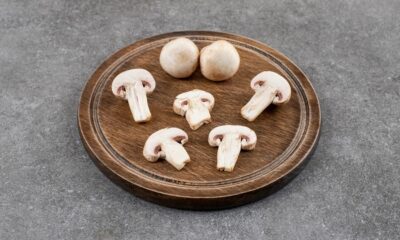
 Health1 year ago
Health1 year agoCan You Smoke Shrooms? Exploring the Myths and Realities
-
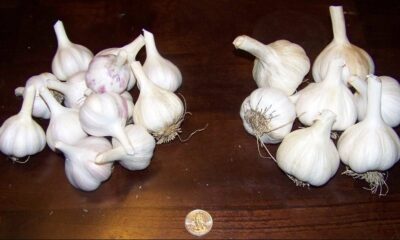
 Articles5 months ago
Articles5 months agoWHAT IS THE DIFFERENCE BETWEEN SEED GARLIC AND FOOD GARLIC?
